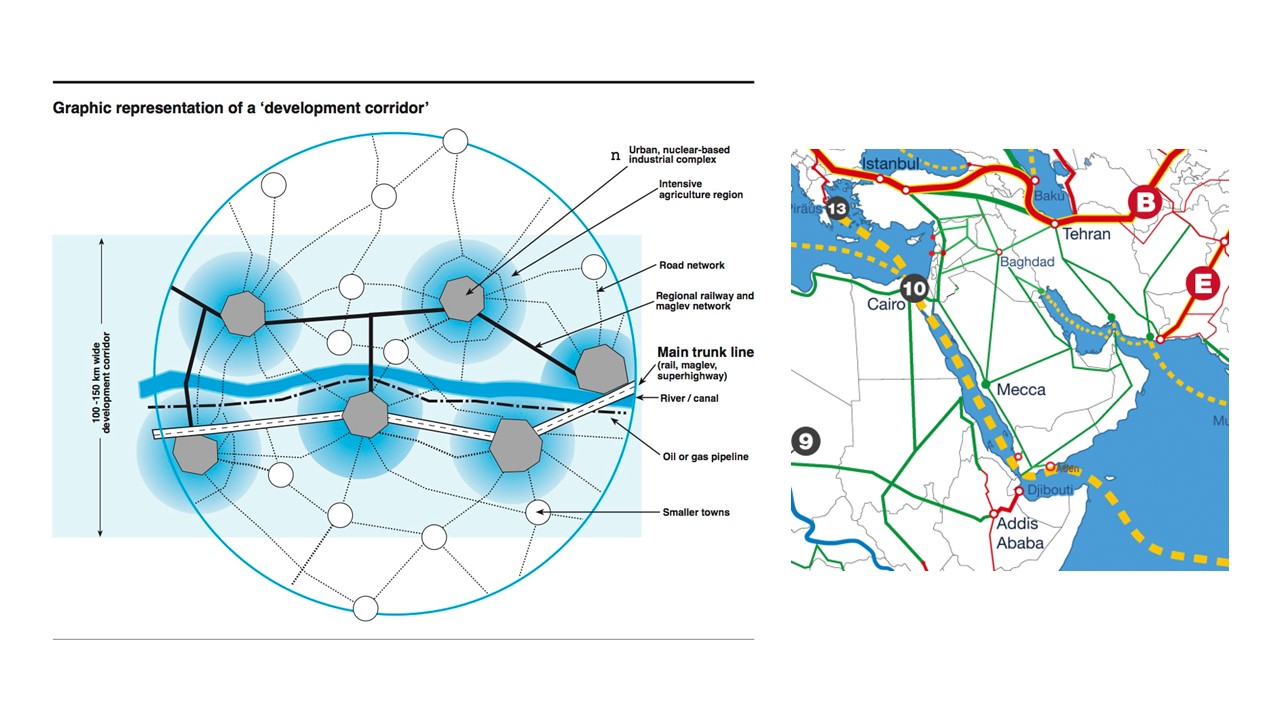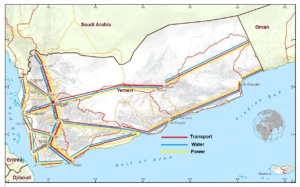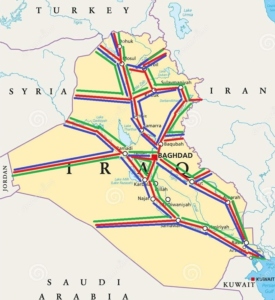Hussein Askary, Vice-Chairman of the Belt and Road Institute in Sweden
The U.S.-backed India-Middle East-Europe Corridor (IMEC) announced during the recent G-20 Summit in India is not merely a pie in the sky but a political fraud which can waste the time and energy of India and the nations of West Asia and Europe. There are no details presented of this project except a verbally pronounced general outline of creating a trade corridor from Indian ports to the ports of the United Arab Emirates and railways through Saudi Arbia and Jordan to Israeli ports on the Mediterranean, then once again from Israeli ports to European ports. There are many absurdities prevalent in this description and in the general discussion it has unleashed globally without any understanding of the physical economic realities such a project would imply.The suggestion that this project will replace China’s Belt and Road Initiative (BRI) misses the most important point in what the Chinese President Xi Jinping launched as the “Economic Belt of the Silk Road” in 2013. The economic “belt” is not a trade route, but a “development corridor”. The lack of understanding among “experts” internationally and even among some Chinese ones of this crucial difference between the purpose of building infrastructure as being economic and social development rather than trade is a serious problem.
If the purpose of the IMEC were to facilitate trade and shipping of goods between India and Europe, then this is a bizarre idea as we will explain below, simply because there is a very convenient route through the Suez Canal operating today. Otherwise, if the IMEC is intended to promote economic development and cooperation among the member states, then they should join China, since the latter has been involved for many years through the BRI in doing just that. There is no reason for Europe or India (which is a great Asian, not Atlantic, nation with enormous potential) why not join hands with China which is the largest economic cooperation and trade partner of the West Asian nations Saudi Arabia and the United Arab Emirates and others. The unmistaken purpose of this American and EU move is to deepen the rift created by some tension related to border issues between the two giant Asian nations in a typical British Empire “divide and conquer” tactic.
Many levels of absurdity
There are different levels of absurdity in this proposal. The most obvious of which is that while the U.S. and the EU, who have failed to finance and build infrastructure in their territories, are proposing to do just that abroad. I have previously discussed why U.S., G-7, and EU alternatives to the BRI are doomed to fail both in terms of the financing and practicality. Another is the fact that Jordan, which is supposed to be a key component of the land-bridge between the Gulf and the Mediterranean was not even invited to the signing ceremony of the IMEC. The fact that the Israeli-Palestinian conflict is not resolved, and the area witnesses recurrent severe armed clashes shows clearly that there are more political points to be gained by the belligerent Israeli government than economic, because the IMEC would push the grievances of the Palestinian people under the rug.
But let’s discuss the “physics” of these claims. If the aim of the IMEC is to simply create a freight route by-passing the Suez Canal, this would be the most expensive and physically irrational undertaking. A typical such absurd discussion spurred by the announcement of the IMEC was in the Israeli press which claimed that the biggest loser here would be the Suez Canal and Egypt. Let’s assume that one of the Post-Panamax ultra large container ships (ULCV) will bring goods from India and dock at the Jabal Ali Port in the UAE on the way to Israel, the Mediterranean, and finally Europe. A typiccal ULCV ship can carry 20,000-25,000 twenty-foot equivalent unit containers (TEU) or 10,000 forty-foot equivalent containers (FEU). The length of a TEU container is 6.1 meters, and an FEU 12.2 meters. If we want to unload these containers unto trains with a maximum number of 39-40 wagons each and with each wagon carrying 2 TEU, we will need 250 trains. As each train is about 580 meters long (1 wagon = 13.7 meters X 40 wagons, plus one locomotive of 32 meters) the chain of our trains would stretch for 145 km! Now imagine that 15 such container ships in addition to 22 bulk ships, 35 tankers, 8 ships of car carriers, and 13 ships of different types pass through the Suez Canal every single day! For the Israeli experts to claim that the IMEC will ruin the Egyptian economy by making the Suez Canal obsolete is a surrealistic statement to say the least. Now, besides, we have to calculate the cost (physical and financial) of unloading the containers from the ship at Dubai ports to the trains and from the trains to ships again at the other end in Israel in addition to paying port service fees at both. Add to that the cost of building around 1,500 km of rail tracks and maintaining them. Add the cost of buying the locomotives and wagons, operating the trains, fuelling the trains, settling transit fees and tariff across the borders of 4 countries, and paying port fees for services at both ports, etc.
Did any of the economic advisors of President Biden or the EU’s Ursula von der Leyen mention these facts and calculation to them? It is important to note that rail freight is three to four times more expensive than ocean freight, but the speed might make up to some of the difference only if the good transported are small in weight and volume and high in value, like electronics, crucial spare parts, electric vehicles, and their batteries. The China-EU Rail Express is the fastest and most efficient transport routes for such goods, transiting from China through Kazakhstan, Russia and Belarus to the EU in 12-15 days on average. But the reality is that without subsidies by the Chinese state, this route wouldn’t be “cost-effective” if we merely look at the financial profit of the transport activity per se. But because of economic and strategic considerations this route is maintained by all parties. Even the outbreak of the Ukraine war could not stop this important trade route.
What is the “development corridor”?
Putting aside all the shallow discussions about “trade route wars”, what should be interesting for all economists, analysts, and policy makers is to study the impact of infrastructure development on the productivity and economic and social development of nations.
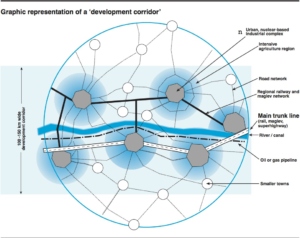
My first encounter with the concept of the “development corridor” (see image) was in 1996 when my late teacher, the great American economist and thinker Lyndon H. LaRouche Jr. (1922-2019) was advising us members of a team of the Schiller Institute while we are preparing the first ever comprehensive economic and scientific report on the Eurasian Land-Bridge / New Silk Road, an idea which can be stated with no exaggeration as his brainchild. China was independently developing its own New Silk strategy, but consultations between Chinese experts and the Schiller Institute were ongoing for many years. The 290-page illustrated report was published in January 1997 under the title “The Eurasian Land-Bridge, The ‘New Silk Road’ – locomotive for worldwide economic development”. The notion of the “development corridor” is embedded in what LaRouche has developed as “physical economics”, a scientific method of assessing economic progress based on the impact of new scientific and technological breakthroughs on the productivity of society and hence what he called the “relative, potential population density”. This branch of economics he attributes to the successive works of the universal genius Gottfried Wilhelm Leibniz (1646-1716), Karl Friedrich Gauss (1777-1815), and Bernhard Riemann (1826-1866). Physical Economics banishes all fetish attachments to money and trade, as purely political instruments that are useful as tools of policy making but not the decisive element in economic processes.
The modern development corridor is accordingly a 100-150-kilometre-wide belt of economic activity, at the centre of which transport, power, water, and telecommunications infrastructure are the skeleton, spine, and nervous system of an economy. Around these infrastructures, new urban centres and agro-industrial zones are built. The purpose of infrastructure is to augment the use of the natural and human resources of an area and connecting it to other such areas on a national, regional, and transcontinental scale. “trade” is thus the transfer of technology and materials between these regions to enhance each other’s productivity and growth, using the comparative advantages of each region. This is the same concept presented by President Xi as the “economic BELT” of the Silk Road in 2013. It is the same concept that is steering the development along the Yangtze River Economic Belt, The Greater Bay Economic Belt, and the Beijing-Tianjin Economic Belt in China. It does not consider “promotion of trade” as its primary goal. Economic development is the primary goal, with increased trade as a natural by-product.
Therefore, when you hear about initiatives based on money, trade, and export of raw materials as the primary goal, you must immediately press the alarm button. This is my primary source of scepticism of such Western “alternatives” to the BRI as Build Back Better World, Global Gateway, and now this IMEC. Of course, I have other reasons of political nature to be sceptical of these initiatives as they are geopolitical in nature and are aimed primarily at undermining China and the BRI with no benefit for any party.
Development corridors of West Asia
Mr. LaRouche, and myself, in our dialogues with the leaders of the nations of West Asia and Arab world advised to build these development corridors, and encouraged to build nuclear power, in order to reduce dependency on the export of raw oil and natural gas at low prices and instead use these raw materials as industrial feedstock for petrochemical and chemical industries that would raise the value of each barrel of oil several degrees of magnitude. The UAE, Saudi Arabia, and Egypt are pioneering this shift form raw material exporters to industrial nations in this region. China is playing a key role in this process, but other nations too like South Korea, Japan and Germany. Everyone is welcome to contribute to this win-win process. Naturally, these countries were also advised to build transport infrastructure on a massive scale to utilize their geographical location as the “crossroads of continents and oceans”.
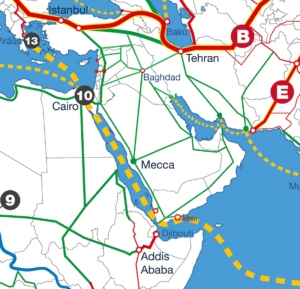
The ”development corridor” along the New Silk Road and BRI has been at the core of my proposals as representative of the Schiller Institute to West Asian nations as post-war reconstruction projects. We presented Operation Phoenix to the Syrian government in 2016, Operation Felix to the Yemeni government in 2018, and the Iraqi Development Corridors to the Iraqi government in November 2022. LaRouche was sceptical to the Oslo Agreement in 1993, and proposed the Oasis Plan of physical economic development as the basis for peace and not merely political agreements.
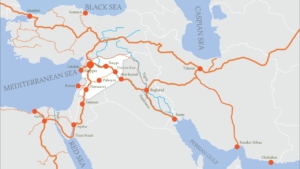
Reality versus illusion
When the U.S. proposes such a project as the IMEC, its leaders assume that this will fill an empty space in the region. While there is a great room for improvement in West Asia’s and Europe’s economic space, China and the BRI have already been busy building the structures of that space for years. Take for example the route of the IMEC. China’s COSCO is already running the Piraeus Port in Greece after investing greatly to make it one of the most important maritime hubs in the eastern Mediterranean. Chinese companies are building railways to Serbia and Hungary to enhance connectivity in Eastern and Central Europe. China built and developed the two key ports in Israel, Haifa Bayport and Ashdod Port. China’s CRRC is heavily involved in the Etihad Rail (UAE) network in the UAE for both passenger and freight rail, which will also connect to the rest of the Gulf Cooperation Council (GCC) countries in the next stage. Saudi Arabia and China are negotiating the building of the Saudi-Landbridge to connect the eastern part of Saudi Arabia on the Gulf to the west coast on the Red Sea. It is important to emphasize here that both the UAE and Saudi rail networks are not built primarily to transit goods between Asia and Europe, but to connect mining sites of bauxite, phosphate and other ores to newly built industrial zones. China has built one of the largest industrial zones in the Saudi west coast in Jizan, with petrochemicals and logistics as the core activity. China built the first high-speed passenger rail for pilgrims from Jedda to Mecca. China has been involved in developing the container terminal in Khalifa Port in Abu Dhabi. There are countless other projects that can be named that will tangent the proposed IMEC. But rather than working with China, the U.S. and EU are proposing to side-step it. This will never happen because it is physically impossible. The nations of the region, especially Saudi Arabia and the UAE have already made up their mind what kind of partnership they want to forge, and China is a model for that.
Going east while remaining in the west
Let’s check the most recent developments in this concern.
One of the biggest breakthroughs in the West Asia region in the recent decades was President Xi’s visit to the Saudi capital Al-Riyadh in December 2022, where he held three summits with Saudi leaders, with GCC leaders, and with Arab league leaders. The outcome and subsequent developments of this visit are of historical importance. The China-brokered Saudi-Iranian agreement to normalize relations in March 2023 was a game changer in the whole region. The admission of Saudi Arabia, the UAE, Egypt and Iran to the BRICS was another boost of the new paradigm shift in the world. However, we focus here on concrete and tangible projects resulting from this development.
In his speech to the GCC leaders in Al-Riyadh on December 10, President Xi outlined the concrete economic and financial measures China was offering to work with the GCC immediately. The “five points” should be of interest to study for any serious analyst. They include long-term trade in oil and gas in local currencies, infrastructure projects extending to nuclear power, space exploration and space technology, telecommunications and AI, industrial projects, and transport infrastructure projects. One day before the China-GCC Summit President Xi and Saudi King Salman ben Abdul-Aziz reached a Comprehensive Strategic Partnership agreement. This partnership is symbiotic with Saudi Vision 2030. Immediately, 30 memoranda of understanding (MoUs) were signed between Chinese and Saudi entities. These were concretized as contracts worth US$ 10 billion during the China-Arab Business Forum in Saudi Arabia in June 2023.
China’s trade with Arab countries reached US$ 450 billion in 2022, and is approaching China’s trade with the EU, which stood at US$ 650 billion. It is projected that China’s trade with the Arab world would surpass the EU in the coming years as cooperation will speed up in all relevant fields. One such indicator was the June 2023 China-Arab Business Forum where China-Arab economic cooperation was put on a fast track.
On the eastern shore of the Gulf, China and Iran (a non-Arab country) have reached a similar Comprehensive Strategic Partnership that extends for 25 years, using a mechanism of “oil for technology”. Iran was last year admitted to the Shanghai Cooperation Organisation as a full member, and to the BRICS this year. Iran is also maintaining very good relations with India and Russia, where a very real “corridor” between the three is operational now under the International North-South Transport Corridor” (INSTC). In this region, there is no more room for Anglo-American zero-sum games as nations are looking for their own interest in a win-win fashion overcoming their ideological and nationalistic emotions.
Why is China a reliable partner?
Many surveys conducted by Western institutions show the popularity of China in the eyes of Arab people, especially the youth. Even if we put aside the horrific impact of the wars launched by the U.S., Britain and their allies in Nato and the EU on the hearts and minds of the people in the Arab world and West Asia, China is popular based on its own merits.
China has proven that a developing nation can rapidly industrialize and rise in the world economic ranking. But that is based on building a solid physical economic basis with modern high-standard infrastructure at its core, an important lesson for other developing nations. China has become the world’s leading engineering and construction power. It has also become a leader in hi-tech fields as telecommunications and space technology, robotics, chemical and petrochemical industries which are very attractive for the oil and gas producing nation in the region. China has become home to the most solid industrial supply chain on the planet. China has an enormous financial arsenal through which it provides long-term and low-interest credits. China will continue to be the world’s largest and most stable importer of oil and gas from this region at least until 2060, which makes it a reliable and stable buyer. China has a long-term vision for its development until 2049, which makes economic partnership with it a stable and long-term enterprise. China has a concrete and mutually beneficial vision of its relations with the region and the world through the BRI, the Global Development Initiative, the Global Security Initiative, and the Global Civilization Initiative.
Politically, China has shown a great deal of good will and solidarity with these nations through many crises, especially the COVID-19 pandemic. China has never interfered in the internal affairs of the nations of West Asia or other nations. Moreover, in the eyes of the Arab people, China is admired for its unwavering and principled stance on the Palestinian issue based on achieving the rights of the Palestinian people of peace through justice and adhering to United Nations resolutions.
India would do well by joining hands with China, Pakistan, and other nations of the region to avoid the pitfalls of British geopolitics. The field is wide open for such a promising economy as India’s with its deep history to play a positive role in Eurasia and Africa. The physical-economics realities of the world are the determining factor here, not the wishful thinking of politicians who are completely detached from reality.
Related items:
G-7 Alternative to The Belt and Road: All That Glitters Is Not Gold!

